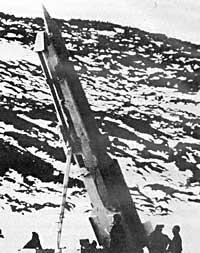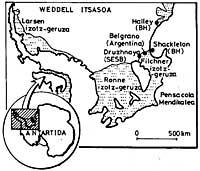Decreased ozone levels
Introduction
In May 1985 Joe Farman, B. Gardiner and J. Atmospheric measurements made by the Sres. Shanklin at Halley Bay station (on the shores of the Weddell Sea) since 1959 were published in the journal "Nature". According to these three researchers from the British Antartic Survey, a British environmental research body, the decrease in ozone levels in the atmosphere of the South Pole has been 40% between 1979 and 1985. Researchers from other institutions have confirmed this data. For example, NASA geophysicists Aldrin Krueger and Richard Stolarski claim that the ozone level has decreased by 16% from 1984 to 1985.
Ozone Physics
The ozone is formed in the equator at 40 km of height and disperses towards the poles. Despite being in small percentages throughout the atmosphere, it is of great importance since it is a controller of the passage of ultraviolet rays, that is, lets pass a percentage of ultraviolet rays from the sun. It also performs the function of a thermos, accumulating the heat provided by the sun's rays during the day. If this heat did not accumulate, the nights would make great ice. Therefore, the decrease in the amount of ozone would mean a change in ecological balance on the one hand and in skin diseases (cancer, burns, etc.) mutations.
The decrease in ozone levels occurs in October, early southern spring. Ozone levels are normalized from December.
The influence of anticyclones and depressions on atmospheric circulation in the South Pole is less than in the North Pole. The atmosphere of the South Pole instead of having an undulatory movement has a circular motion. This movement is called polar swirl. Therefore, the Polo is isolated from the surrounding lands. During the polar winter it is night. But in September the sun appears and then some changes occur. In the center of the whirlpool air rises and falls at the edges. Between October and November, the thermal imbalance generated sends the whirlpool to the Atlantic. This situation makes the Antarctic a chemical reactor.

With the aim of knowing this phenomenon, the work has been divided among four groups of researchers. For this purpose, the ozone layer, an aircraft with optical devices and an infrared spectrometer will be used along with other devices. Data such as ozone reduction in 20-30 days and 12-20 km height are known through measurements already made.
Decreased ozone levels: four theories
Pending current research, there are four main hypotheses that try to explain this phenomenon. Let's look at it briefly.
The first hypothesis says that the air that goes up the center of the whirlpool is very poor in ozone, while the one that goes down the banks of the whirlpool is very rich, but the prestigious researcher of the Belgian Space Institute, Guy Brasseur, has rejected this theory.
The second hypothesis is based on the influence of the sun. According to some researchers, solar rays drive the formation of nitrogen oxide molecules by removing ozone molecules. For various reasons this theory has also been ruled out.
The third hypothesis takes into account human influence. Specific reference is made to the effect of pollutants, including some halogenated hydrocarbons, such as those used as propellants in aerosols. The accumulation of these compounds would favor the release of chlorine and would cause ozone destruction. According to the researchers, this hypothesis has its foundation, but, however, many points remain dark.
The last hypothesis provides natural reasons. According to this hypothesis, in the short and medium term there is nothing to worry about:
- Because scientists are studying the process closely. Because they are not irreversible processes.
- Its duration is similar to other natural processes.
Final comments

From these hypotheses we can draw some conclusions. If it is a natural phenomenon, it will have to be analyzed from there and it will be a good opportunity to better understand these phenomena. But if it is artificial and pollutants have the responsibility for this situation, the solution of the problem remains in the hands of man.
In one way or another, the final reality is the same, that is, the decrease of the ozone would increase the amount of ultraviolet rays that impact on the Earth and, therefore, in addition to the skin cancer mentioned above, the death of plants and animals, mutations, alteration of the atmosphere, etc. They would spend a long time.






